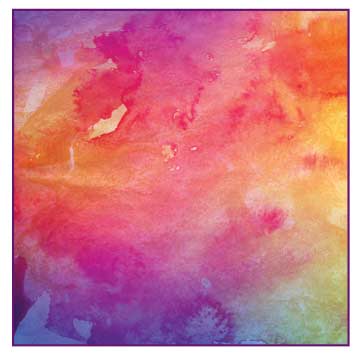 J Clin Aesthet Dermatol. 2023;16(6):30–36.
J Clin Aesthet Dermatol. 2023;16(6):30–36.
by Juliana Sarubi, MD; Christine Guarnieri, MD; Maria P. Del Nero, MD; Cristhine Kamamoto, MD, PhD; Mamy Honda, MD; Fabio Saito, MD; and Alessandra Haddad, MD; PhD
Dr. Sarubi is a Dermatologist in Private Practice in Belo Horizonte, Brazil. Dr. Guarnieri is with Centro de Dermatologia in São Paulo, Brazil. Dr. Paula Del Nero is with Clínica Healthy in São Paulo, Brazil. Dr. Kamamoto is with Galderma in São Paulo, Brazil. Dr. Honda is with Galderma in São Paulo, Brazil. Dr. Saito is with the Brazilian Society of Plastic Surgery in São Paulo, Brazil. Dr. Haddad is an Associate Professor of Plastic Surgery at Federal University in São Paulo, Brazil, and a Coordinator of the Lato Sensu Graduate Program in Laser Cosmetic and Aesthetic Procedures at Hospital Israelita Albert Einstein in São Paulo, Brazil.
FUNDING: Medical writing services were funded by Galderma, LLC.
DISCLOSURES: Dr. Sarubi is a speaker and consultant for Galderma. Dr. Haddad is a speaker, consultant, and investigator for Galderma. Drs. Guarnieri and Del Nero are speakers for Galderma. Drs. Saito and Kamamoto are employees of Galderma. Dr. Honda is medical advisor for Galderma.
ABSTRACT: Objective. The robust safety and efficacy profile associated with the use of biodegradable fillers such as poly-L-lactic acid (PLLA) for facial rejuvenation has resulted in a growing interest in off-label use for various aesthetic applications, including gluteal augmentation. The authors describe a novel targeted and individualized technique of PLLA injection into the buttock region.
Methods. The technique involves clinical and anatomical evaluations of the gluteal region, and there are three distinct approaches for injecting PLLA in the gluteal region based on the most important factor to be improved: (1) skin quality, (2) contour and lifting, or (3) projection and volume.
Results. This novel technique is associated with favorable patient outcomes in terms of improvements across all key areas of gluteal augmentation; improvement in skin quality and laxity, contour improvement and lifting, and gluteal volume and projection. Since its initiation, this technique has been found to be both cost-effective and clinically efficacious, with demonstratable benefits achieved with a lower volume of PLLA compared to other PLLA injection techniques.
Limitations. Assessment of patient outcomes with this technique have, to date, been subjective clinical observations, which does not include quantitative outcomes such as patient satisfaction data or safety outcomes.
Conclusion. We describe an optimized and individualized approach for injecting the collagen biostimulator PLLA in the gluteal region according to the needs of each patient.
Keywords. Poly-L-lactic acid, aesthetic medicine, gluteal augmentation, aging, skin quality, collagen biostimulator
Although the concept of body beauty has changed over the years, the size and shape of the gluteal region remains a symbol of femininity.1–3 The overall shape of this region is influenced by the underlying bony framework, the gluteus maximus muscle, subcutaneous fat topography, and skin, to give an individualized shape and aesthetic.4
The gluteal region is increasingly seen as an important element of physical attractiveness, particularly in women, and this has led to the rise of subcutaneous buttock augmentation, the Brazilian butt lift, as one of the most popular plastic surgery procedures in recent years.1–3,5,6 Aesthetically pleasing gluteal features include lateral depression, the gluteal fold (sacral triangle), supragluteal fossettes, infragluteal fold, and gluteal projection (Figure 1, right panel).1,3 An attractive gluteal projection has been defined as a 2:1 ratio for the distance between points W and Y compared to points W and X (Figure 1, left panel).1,3 There are significant differences in desired buttock size and shape based on age, ethnicity, and religion, with patients of Hispanic or South American descent traditionally preferring a larger buttock in the lateral view representing an extreme upside-down heart with more fullness in the lateral thigh area.6 The gluteal region is an area of high expectation and demand among Brazilian women and different complaints are brought to the consultation. Based on 17 years of experience in subcutaneous buttock treatment, the authors observed that, for an excellent result, each demand is best met by a specific treatment strategy.
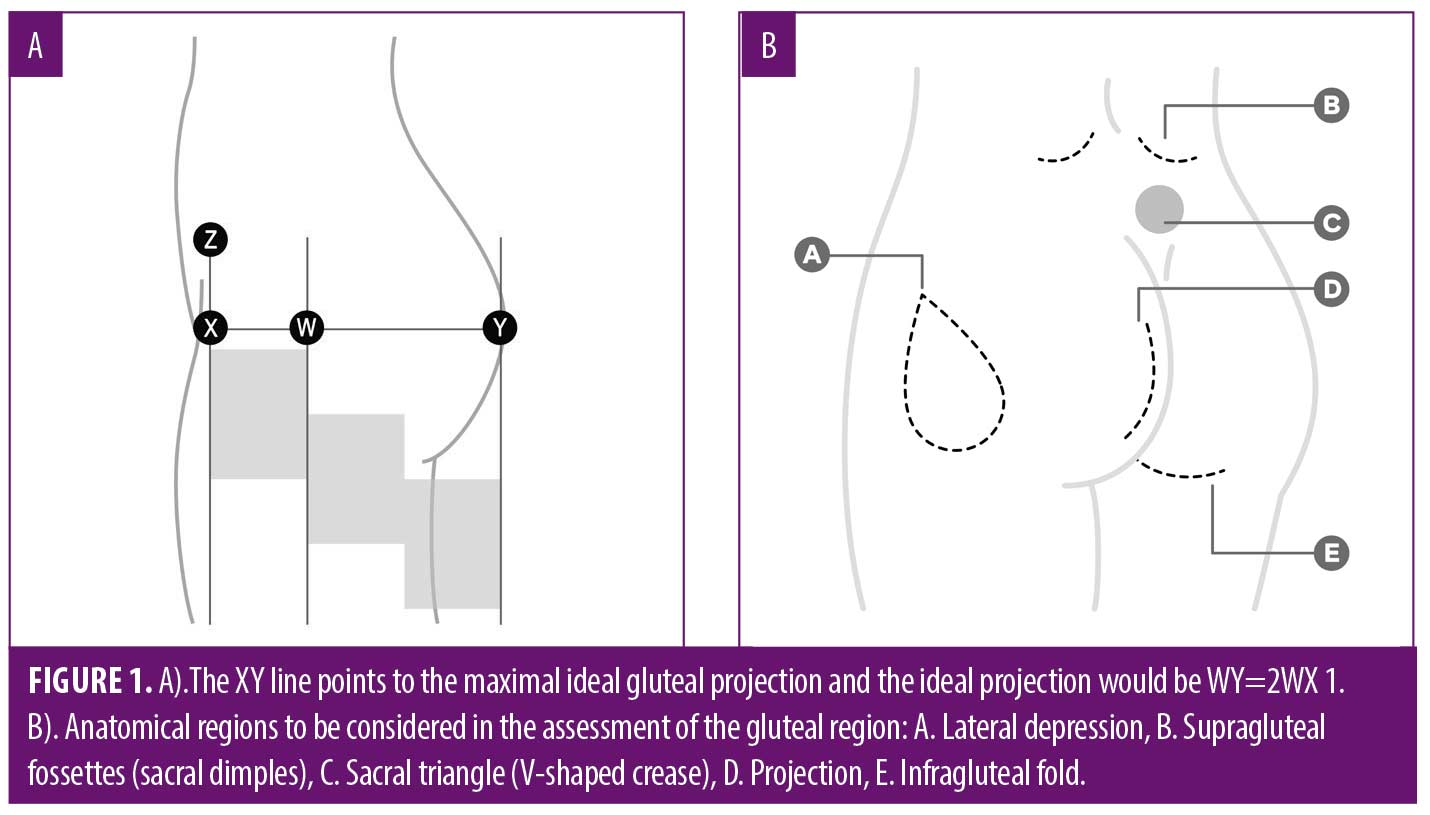
The desire for gluteal aesthetics has traditionally been met with a variety of surgical techniques including the use of submuscular implants and lipoplasty. Augmentation gluteoplasty through silicone implant placement has been associated with high (21%) complication rates, and although autologous fat grafting is a popular approach, it is not suitable for all patients and has a complication rate of around 10 percent.7,8 Autologous fat grafting is associated with a mortality rate significantly higher than other aesthetic procedures.9 More recently, there has been growing interest in developing less invasive approaches with lower complication rates for gluteal enhancement, a need which is readily met by biodegradable collagen biostimulator such as poly-L-lactic acid (PLLA [Sculptra®]).10
PLLA (Sculptra®) is an absorbable, biodegradable, injectable biostimulator that can be used to gradually stimulate collagen formation and restore volume. Microparticles of PLLA help gradually revitalize the skin’s structural foundation, providing results for more than two years. Repeated PLLA treatments may improve skin quality in a time-dependent manner.10–15 First approved for aesthetic use in 2009 in the US, and currently available in more than 40 countries, the robust safety and efficacy profile associated with PLLA for facial rejuvenation has resulted in a growing interest in off-label use for various aesthetic applications, including gluteal augmentation.16–19 A retrospective clinical review has confirmed the utility of PLLA for the safe and effective aesthetic enhancement of the gluteal region through volume amplification, improved skin texture, and softened cellulite dimpling.18
Thus, PLLA affords an attractive treatment option for patients. Historically however, there has been no clear consensus on the appropriate use of PLLA in this area. Expert recommendations regarding the use of injectable PLLA for off-face areas, including contour deficiencies of the buttocks, have recently been developed by international leaders in the field of aesthetics, dermatology, and plastic surgery.20,21
The overall aim of this article is to expand on these recommendations and to describe the complete approach adopted with the ‘Firm and Up’ technique of PLLA (Sculptra®) injection into the gluteal region; from patient selected to targeted and individualized injections. ‘Firm and Up’ is an individualized strategy involving three distinct approaches to optimize improvements in skin quality, contour definition, and volumization to meet the specific aesthetic requirements of each patient.
This novel technique has been developed and refined over a period of ten years based on clinical experience and the consensus outcomes from two scientific advisory board meetings with the overall aim of optimization in results using the least amount of PLLA. Here, we provide a detailed description of the ‘Firm and Up’ technique and the clinical experience of the authors which includes more than 100 cases treated over the last five years.
Methods
Patient selection. The ‘Firm and Up’ technique is most appropriate for patients aged 35 to 55 years with a body mass index (BMI) 27–30 kg/m2 or less, although in some cases patients up to five years older or younger may be considered.20 The ideal patient will have a BMI between 20 to 29 and mild to moderate laxity in gluteal area. The authors believe patients with lower grades of flaccidity show a more optimal clinical response to the use of PLLA, while patients with more intense flaccidity are more challenging and will likely require a greater amount of product and sessions. When assessing flaccidity, it is also important to assess the fatty tissue and its topography.
Clinical assessment. Detailed clinical assessments of infragluteal fold, degree of flaccidity, projection, gluteal shape, and skin surface irregularities are required to define the overall objectives of the procedure. These considerations guide the technique, which includes three distinct approaches for PLLA injection based on patient input regarding the most important factor or aspect to be improved, including skin quality, contour, lifting or projection and volume.
Length and definition of the intragluteal fold play a significant role in the aesthetics of the gluteus, with a more extended fold suggesting ageing and flaccidity accompanied by ptosis. Flaccidity, with or without cellulite, is characterized by reduced firmness of the skin and subcutaneous tissue with hyperdistention and loss of support capacity. When evaluating the buttocks, a physical examination is essential to verify the degree of existing flaccidity, irregularities of skin relief, and the presence of associated cellulite. Assess the patient in a static and dynamically way, especially during muscle contraction and passive movement. Photography has been employed to characterize cellulite severity, and the impact of treatment.20 Finally, anteroposterior projection is primarily responsible for the perceived aesthetic beauty of the gluteal region and is evaluated in profile. It is necessary to determine the four fixed points described in Figure 1, left panel: W. greater trochanter projection point on the skin; X. point of maximum pubis projection; Y. point of maximum gluteal projection; and Z. anterosuperior iliac spine. As previously noted, the ideal gluteal projection is defined as a 2:1 ratio for the distance between points W and Y compared to points W and X (WY=2WX).1,3
Overall gluteal shape should also be reviewed as part of the assessment. The patient should be made aware this cannot be changed due to associations with pelvic bone configuration and hormonal status.4
PLLA reconstitution/dilution and administration. PLLA is reconstituted with sterile or bacteriostatic water before use. The recommended volume for dilution is 16–20mL including an optional 1mL 1% lidocaine. Once reconstituted, the product should be used immediately. Both needles (25G) and cannulas (18–22G) are recommended for administering PLLA (Table 1). Retrograde fanning is the recommended injection technique for both the needle and cannula, and linear threads or micro-boluses are recommended for needles.

The ‘Firm and Up’ injection technique. This novel technique represents an optimized and individualized technique for PLLA (Sculptra®; Galderma Laboratories, L.P. Fort Worth, Texas) injection according to the needs of each patient and involves three distinct approaches based on the most important factor to be improved: (1) skin quality, (2) contour and lifting, or (3) projection and volume.
The videos that accompany this article (Videos, Supplemental Digital Content 1 and 2) depict the demarcation strategy and injection technique utilized in the ‘Firm and Up’ technique, which is unique in its demarcation of the gluteal region into two parts: the 7-shaped frame (Figure 2A) and the target (Figure 2B). It is also unique in its individualization with the amount of PLLA and distribution of the product variable depending on the objectives to be achieved (Figure 3).
Supplemental videos below:
Supplemental Video 1. Sculptra Firm and Up Marking.
Supplemental Video 2. Sculptra Firm and Up Injection.
The 7-shaped frame aligns with the upper and lateral-inferior region of each buttock in the shape of a number 7 (Figure 2A), with the upper edge located along the iliac crest, 2–3cm below it, demarcated from medial to lateral direction, followed by marking the lower edge diagonally towards the tuberosity of the ischium. This marking corresponds superiorly to the insertion region of the gluteus maximus muscle and, inferiorly to the area with the highest concentration of cellulite and where the vectorization for the elevation effect is achieved. The frame is always the same, and will always be treated, regardless of the objective, as it improves the contour and elevation of the gluteal region. The amount of PLLA to be applied varies depending on the objectives to be achieved. The injection will be conducted in a vector fashion (fanning technique) with PLLA retro-injection at four cannula entry points, as shown in Figure 2.
To access the target area, the gluteal region should be divided into four quadrants. The target is the area where the applied product is most concentrated. Its location will vary depending on the treatment objective (Figure 2B): for volume and projection, the upper-inner quadrant will be the target; to achieve contour and elevation, the upper-outer quadrant should be chosen; to improve skin quality, the target will involve the entire region of skin flaccidity or cellulite-related depressions.
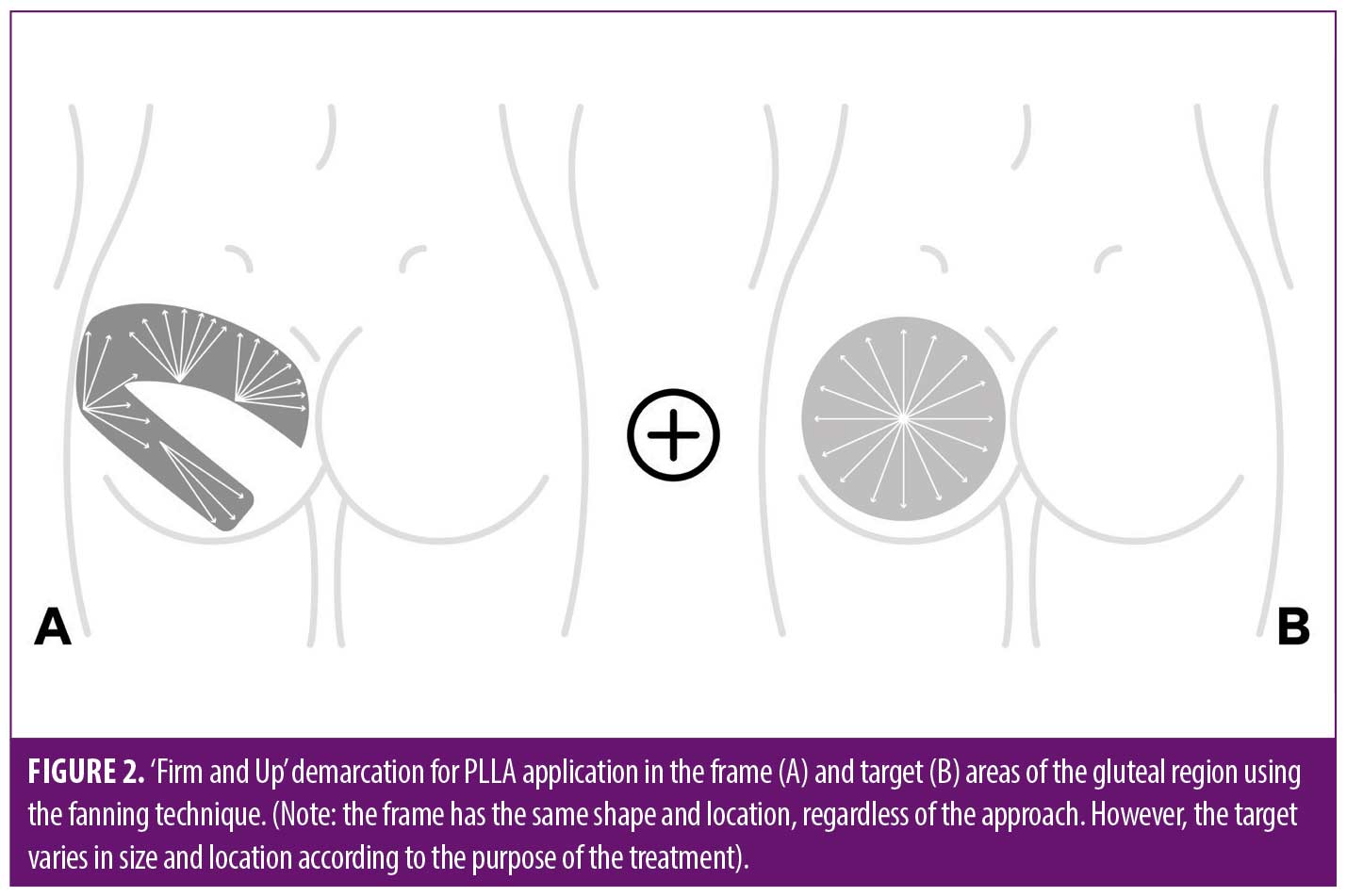
The overall objectives of the ‘Firm and Up’ technique are to improve skin quality, improve the contour of the gluteal region to achieve a lifting effect, and increase the volume of the gluteal region and give it more projection. To achieve each of these objectives, a different PLLA approach and injection volume are required. However, the main objective of this technique is to deliver desired outcomes with a minimal amount of product compared to other injection techniques (Figure 3 and Table 1).
Improving skin quality. Although PLLA can be distributed in the entire gluteal region, this approach involves targeting the sites of greater texture alteration, such as flaccidity, irregularities in skin surface, crepe skin and cellulite. Thus, the application of PLLA occurs in the frame and the target area and will vary according to the presence of cellulite and greater flaccidity. The volume should be divided as follows: 50 percent in the frame and 50% percent distributed along the target area to be injected with a cannula and/or needle. (Figure 3A and Table 1).
Improving contour and achieving lifting. To improve the contour of the gluteal region and achieve a lifting effect, the injection of PLLA is performed using the following volume proportion: 60 percent in the frame and 40 percent in the target region, which in this case is the upper-external quadrant (Figure 3B and Table 1).
To increase volume and enhance projection: The aim is to increase the volume of the gluteal region and give it more projection. Here, the target is the upper-internal quadrant. PLLA is applied: 60 percent on the target and 40 percent on the frame (Figure 3C and Table 1). When the goal is to increase volume, it is necessary to be aware that the amount of product to be applied must be greater than when the goal is to achieve a lifting effect.
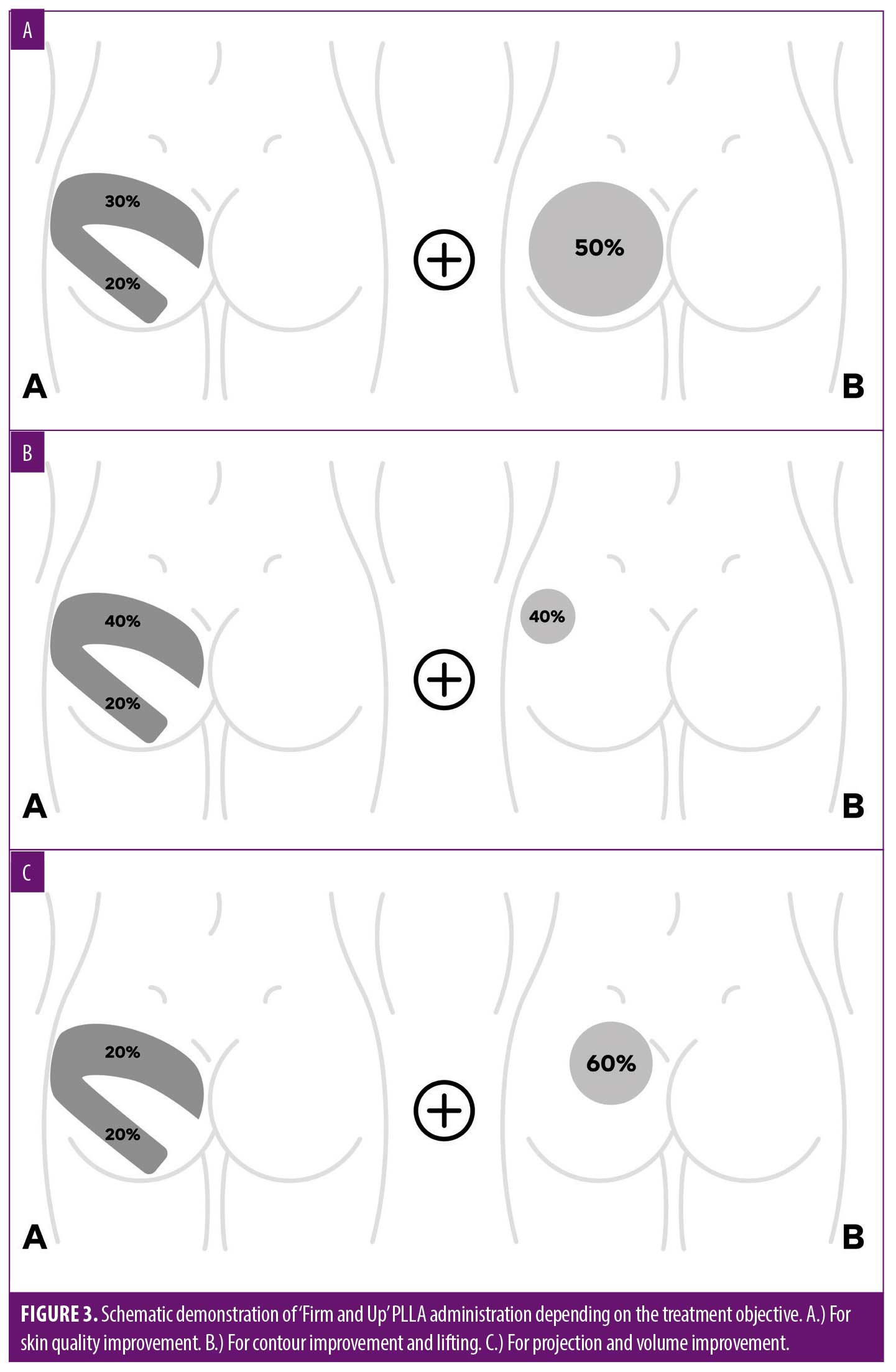
It is worth noting that with all three approaches, it is also possible to use the Subcision® technique to improve skin quality in areas with cellulite associated with flaccidity. Subcision® is a minor surgical procedure for treating moderate to severe cellulite depression.22 The combination of Subcision® plus PLLA in the same treatment session has been demonstrated to promote safe and desirable results for cellulite associated with flaccidity.23
PLLA dose. The exact amount of product required will vary and is dependent on BMI, age, size of the osteal frame, size and area of buttocks, treatment goals, and the degree of desired lifting and volume augmentation.20 The volume used in each side of the gluteal area will ultimately depend on the patient’s needs and whether they desire increased lift and volume or improvements in texture and contours. In general, a larger amount of product is needed for volumization than for textural irregularities.20 In the authors experience, the minimal recommended dosing for satisfactory results for ‘Firm and Up’ is 1 to 2 vials per side per session over 2 to 4 sessions and 6 to 8 weeks apart (Table 1). It is important to note that this amount will vary depending on the patient’s need, based on the individual anatomic need and cultural and regional differences. In the author’s experience, the maximum volume applied was four vials per side per session.
Post-treatment care. Following ‘Firm and Up’, it is recommended that the injector massage the treated area in a circular fashion immediately after treatment for a minimum of two minutes.10 The massage should be repeated at home for five minutes twice a day, for five to seven days.10,21 Patients should avoid physical activity and sun exposure following the first 24 hours of treatment to avoid bruising.21
Monitoring. A standardized method of evaluation is required to assess improvements accurately, and it is important to wait until the full course of treatment is complete before results are assessed.20 Substantial improvements are visible at around 12 weeks. However, the full effect takes at least six months to occur. Therefore, the peak treatment effect is apparent around six months after the last treatment session (eight to nine months after the first treatment) and before and after photographs are critically important to allow patients visualize the improvement.20
Expert recommendations for current best practice on the use of injectable PLLA for contour deficiencies of the buttocks highlight that safety problems associated with treatment in the buttocks are likely to appear early and pose less of an issue compared with PLLA treatment for the face.20 They report that the most common and expected side effects after gluteal PLLA injection are bruising, swelling, and or redness.20 Patients should be informed of the potential risk of the complications described in the product label, including nodules and granulomas, and should be encouraged to report any adverse events.20
Results
The clinical experience of the authors includes more than 100 cases treated over the last five years demonstrating that the ‘Firm and Up’ procedure is associated with highly favorable patient outcomes in terms of improvements in skin quality and laxity, contour improvement and lifting, and gluteal volume and projection. Annotations in Figures 4 to 6 highlight improvements in skin condition and localized depression, improvement of gluteal shape, and shorter infragluteal fold, thus representing successful treatment. Since its initiation, this technique has proven to be both clinically and cost-effective, with demonstratable benefits achieved with a lower volume of PLLA compared to other techniques, in the opinion of the authors.
High levels of patient satisfaction and adherence are reported with most patients following a maintenance protocol and returning for repeated treatments. In addition, many patients have recommended this technique to their friends.
The technique is well-tolerated, and no new safety issues associated with PLLA administration using the ‘Firm and Up’ technique have been observed in this sample of treated patients. Bruising is the most frequent AE, occurring in approximately 60 percent of our sample, and we have had no reported cases of nodules and granulomas. In addition, the use of a cannula and a reduced number of entry points is associated with less tissue injury than with other injection techniques. Of note, we observe that bruising and hematoma are smaller in extension with this technique.
Discussion
The ‘Firm and Up’ technique using PLLA represents a cost-effective, clinically effective, and safe treatment option for enhancing the gluteal aesthetics, as demonstrated in Figures 4 to 6. Our experience suggests that the overall objectives of the ‘Firm and Up’ techniques, i.e., to identify the patient’s individual needs and plan the product distribution to achieve this.
Each patient should be clinically assessed, and patient’s must be properly informed to ensure that their expectations are realistic. It is important to clearly identify the patient’s main need and explain the treatment plan to obtain a satisfactory outcome; the key to optimizing outcomes is individualizing treatment according to gluteal assessment and patient need. The ‘Firm and Up’ technique identifies elements of anatomy and aesthetic evaluations that warrant prioritization and the PLLA administration strategy most appropriate for each patient’s needs. Skin quality is an important consideration in the clinical assessment, and in most patients is treated in addition to contour and lifting or projection and volume. Figure 4 illustrates improvements in contour and lifting in a patient whose aim was to improve skin quality, and Figure 5 illustrates improvements in skin quality in a patient whose aim was to gluteal contour and achieve lifting. It is important to highlight that the gluteal region corresponds to an anatomical and aesthetic unit with a morphology defined by bony structure, gluteal muscles, and fat tissue; this technique may not be sufficient to address all body shaping alterations. This technique would not be appropriate in patients with a sizeable gluteal region, a higher degree of sagging and cellulitis, and a high BMI.

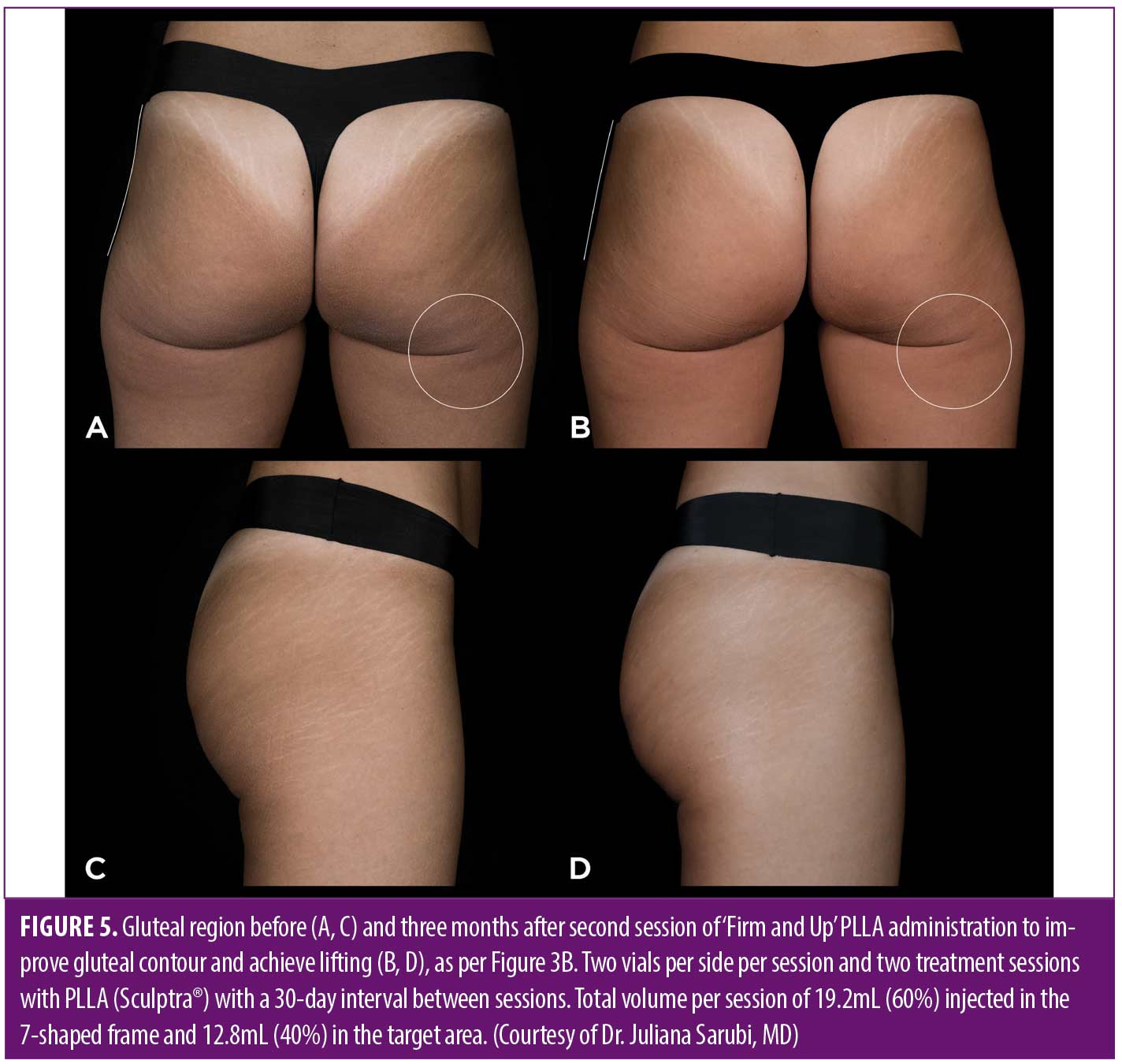
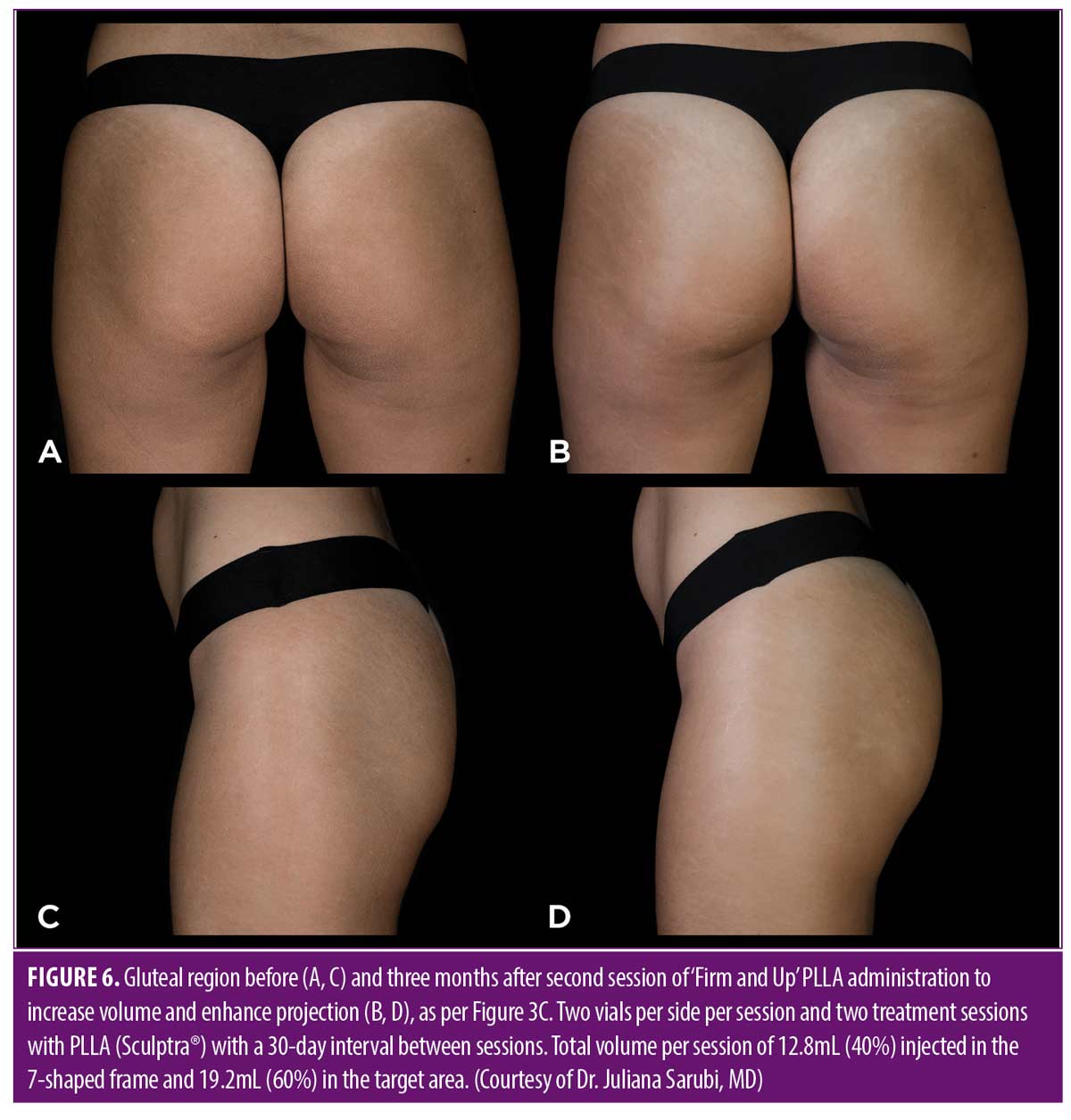
Conclusion
We believe that gluteal augmentation is best achieved through biostimulation treatment with PLLA to improve skin quality, improve contour, achieve lifting, increase volume, and enhance projection.
Based on decades of clinical experience in the use of PLLA, we have observed that, for an excellent result using the least amount of PLLA, each demand is best met by a specific treatment strategy, an objective readily met by the ‘Firm and Up’ technique.
In conclusion, a harmonious and beautiful gluteal region has increasingly been of interest to the female public. This has led to the development and refinement of the ’Firm and Up’ technique, a procedure that provides safe and effective aesthetic improvement in this region. Thus, we describe an optimized and individualized mechanism for injecting the collagen biostimulator PLLA into the gluteal region according to the needs of each patient. The authors strongly believe this publication represents a breaking of paradigms in gluteal augmentation.
References
- Cuenca-Guerra R, Quezada J. What makes buttocks beautiful? A review and classification of the determinants of gluteal beauty and the surgical techniques to achieve them. Aesthetic Plast Surg. 2004;28(5):340–347.
- Nteli Chatzioglou G, Govsa F, Bicer A, et al. Physical attractiveness: analysis of buttocks patterns for planning body contouring treatment. Surg Radiol Anat. 2019;41(1):133–140.
- Cuenca-Guerra R, Lugo-Beltran I. Beautiful buttocks: characteristics and surgical techniques. Clin Plast Surg. 2006;33(3):321–332.
- Mendieta CG, Sood A. Classification System for Gluteal Evaluation: Revisited. Clin Plast Surg. 2018;45(2):159–177.
- Lin MJ, Dubin DP, Khorasani H. Poly-L-Lactic Acid for Minimally Invasive Gluteal Augmentation. Dermatol Surg. 2020;46(3):386–394.
- Mowlavi A, Berri M, Talle A, et al. Objectifying High-Definition Brazilian Buttock Lift Results Using the Buttock Assessment Tool. Plast Reconstr Surg. 2021;148(5):727e–734e.
- Mofid MM, Teitelbaum S, Suissa D, et al. Report on Mortality from Gluteal Fat Grafting: Recommendations from the ASERF Task Force. Aesthet Surg J. 2017;37(7):796–806.
- Sinno S, Chang JB, Brownstone ND, et al. Determining the Safety and Efficacy of Gluteal Augmentation: A Systematic Review of Outcomes and Complications. Plast Reconstr Surg. 2016;137(4):1151–1156.
- Shah B. Complications in Gluteal Augmentation. Clin Plast Surg. 2018;45(2):179–186.
- Sculptra injectable poly-L-lactic acid. Instructions for Use. Galderma Laboratories. 2021.
- Stein P, Vitavska O, Kind P, et al. The biological basis for poly-L-lactic acid-induced augmentation. J Dermatol Sci. 2015;78(1):26–33.
- Brandt FS, Cazzaniga A, Baumann L, et al. Investigator global evaluations of efficacy of injectable poly-L-lactic acid versus human collagen in the correction of nasolabial fold wrinkles. Aesthet Surg J. 2011;31(5):521–528.
- Bohnert K, Dorizas A, Lorenc P, et al. Randomized, Controlled, Multicentered, Double-Blind Investigation of Injectable Poly-L-Lactic Acid for Improving Skin Quality. Dermatol Surg. 2019;45(5):718–724.
- Goldberg D, Guana A, Volk A, et al. Single-arm study for the characterization of human tissue response to injectable poly-L-lactic acid. Dermatol Surg. 2013;39(6):915–922.
- Fitzgerald R, Vleggaar D. Facial volume restoration of the aging face with poly-l-lactic acid. Dermatol Ther. 2011;24(1):2–27.
- Sickles CK, Nassereddin A, Gross GP. Poly-L-Lactic Acid. In: StatPearls. StatPearls Publishing LLC.; 2022.
- Mazzuco R, Sadick NS. The Use of Poly-L-Lactic Acid in the Gluteal Area. Dermatol Surg. 2016;42(3):441–443.
- Durairaj KK, Devgan L, Lee Bs A, et al. Poly-L-Lactic Acid for Gluteal Augmentation found to be Safe and Effective in Retrospective Clinical Review of 60 Patients. Dermatol Surg. 2020;46 Suppl 1:s46–s53.
- Shridharani SM, Tisch GM, Ebersole TG, et al. Clinical experience of poly-L-lactic acid injections for body contouring treatment. J Cosmet Dermatol. 2021;20(6):1655–1662.
- Harper J, Avelar L, Haddad A, et al. Expert Recommendations on the Use of Injectable Poly-L-lactic Acid for Contour Deficiencies of the Buttocks. J Drugs Dermatol. 2022;21(1):21–26.
- Haddad A, Menezes A, Guarnieri C, et al. Recommendations on the Use of Injectable Poly-L-Lactic Acid for Skin Laxity in Off-Face Areas. J Drugs Dermatol. 2019;18(9):929–935.
- Hexsel DM, Mazzuco R. Subcision: a treatment for cellulite. Int J Dermatol. 2000;39(7):539–544.
- Mazzuco R. Subcision™ plus poly-l-lactic acid for the treatment of cellulite associated to flaccidity in the buttocks and thighs. J Cosmet Dermatol. 2020;19(5):1165–1171.

